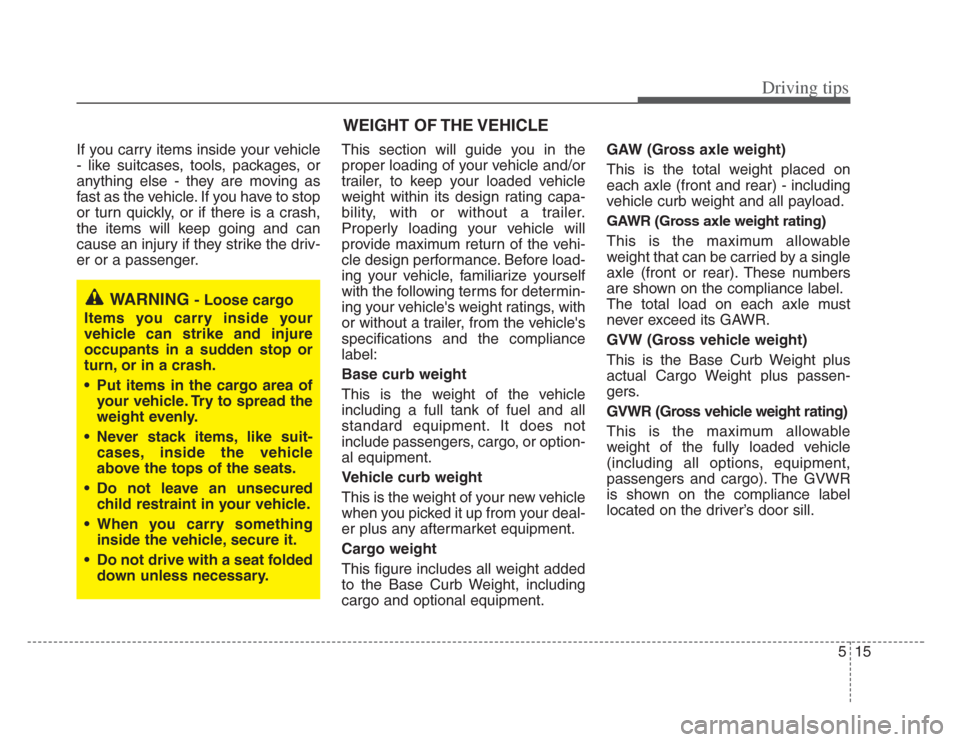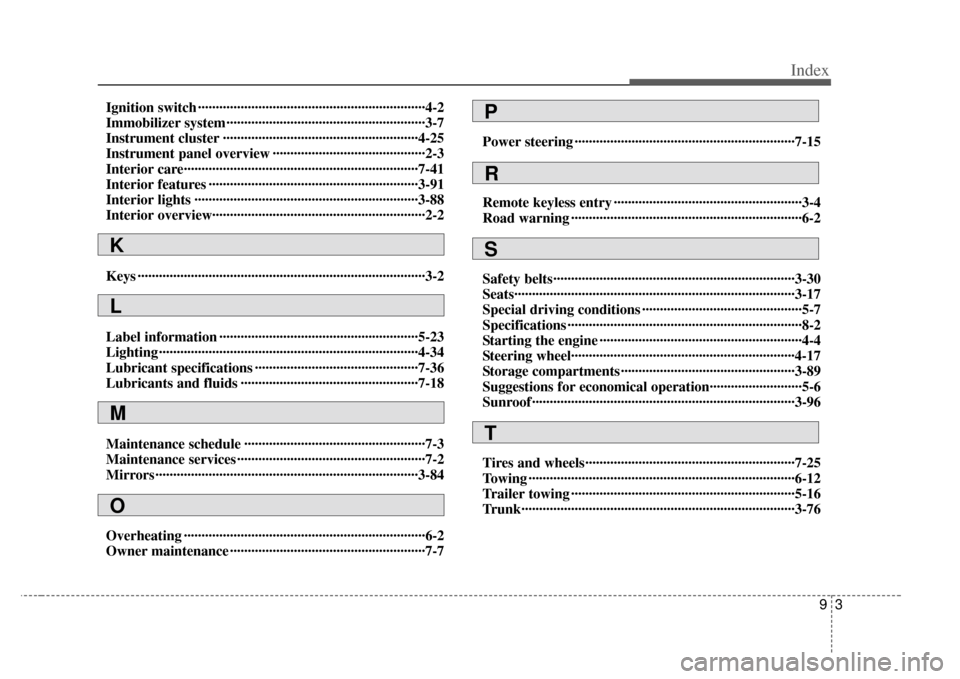Page 199 of 283

515
Driving tips
If you carry items inside your vehicle
- like suitcases, tools, packages, or
anything else - they are moving as
fast as the vehicle. If you have to stop
or turn quickly, or if there is a crash,
the items will keep going and can
cause an injury if they strike the driv-
er or a passenger.This section will guide you in the
proper loading of your vehicle and/or
trailer, to keep your loaded vehicle
weight within its design rating capa-
bility, with or without a trailer.
Properly loading your vehicle will
provide maximum return of the vehi-
cle design performance. Before load-
ing your vehicle, familiarize yourself
with the following terms for determin-
ing your vehicle's weight ratings, with
or without a trailer, from the vehicle's
specifications and the compliance
label:
Base curb weight
This is the weight of the vehicle
including a full tank of fuel and all
standard equipment. It does not
include passengers, cargo, or option-
al equipment.
Vehicle curb weight
This is the weight of your new vehicle
when you picked it up from your deal-
er plus any aftermarket equipment.
Cargo weight
This figure includes all weight added
to the Base Curb Weight, including
cargo and optional equipment.GAW (Gross axle weight)
This is the total weight placed on
each axle (front and rear) - including
vehicle curb weight and all payload.
GAWR (Gross axle weight rating)
This is the maximum allowable
weight that can be carried by a single
axle (front or rear). These numbers
are shown on the compliance label.
The total load on each axle must
never exceed its GAWR.
GVW (Gross vehicle weight)
This is the Base Curb Weight plus
actual Cargo Weight plus passen-
gers.
GVWR (Gross vehicle weight rating)
This is the maximum allowable
weight of the fully loaded vehicle
(including all options, equipment,
passengers and cargo). The GVWR
is shown on the compliance label
located on the driver’s door sill.
WARNING - Loose cargo
Items you carry ins ide your
vehicle can s trike and injure
occupants in a sudden stop or
turn, or in a crash.
• Put items in the cargo area of your vehicle. Try to spread the
weight evenly.
• Never stack items, like suit-
cas es,in side the vehicle
above the top s of the seats.
• Do not leave an uns ecured
child restraint in your vehicle.
• When you carry s omething
inside the vehicle, secure it.
• Do not drive with a seat folded
down unless necessary.
WEIGHT OF THE VEHICLE
Page 268 of 283

733
Maintenance
Traction - AA, A, B & C
The traction grades, from highest to
lowest, are AA, A, B and C. The
grades represent the tires ability to
stop on wet pavement as measured
under controlled conditions on spec-
ified government test surfaces of
asphalt and concrete. A tire marked
C may have poor traction perform-
ance.
Temperature -A, B & C
The temperature grades are A (the
highest), B and C. The grades repre-
sent the tire’s resistance to the gen-
eration of heat and its ability to dissi-
pate heat when tested under con-
trolled conditions on a specified
indoor laboratory test wheel.
Sustained high temperature can
cause the material of the tires to
degenerate and reduce tires life, and
excessive temperature can lead to
sudden tires failure. Grades A and B
represent higher levels of perform-
ance on the laboratory test wheel than
the minimum required by the law.Tire terminology and definition
s
Air Pressure : The amount of air
inside the tire pressing outward on
the tire. Air pressure is expressed in
kilopascal (kPa) or pounds per
square inch (psi).
Accessory Weight : This means the
combined weight of optional acces-
sories. Some examples of optional
accessories are, automatic transmis-
sion, power seats, and air condition-
ing.
Aspect Ratio : The relationship of a
tire's height to its width.
Belt: A rubber coated layer of cords
that is located between the plies and
the tread. Cords may be made from
steel or other reinforcing materials.
Bead: The tire bead contains steel
wires wrapped by steel cords that
hold the tire onto the rim.
Bias Ply Tire : A pneumatic tire in
which the plies are laid at alternate
angles less than 90 degrees to the
centerline of the tread.
WARNING - Tire temperature
The temperature grade for this
tire is e stablished for a tire that
i s properly inflated and not
overloaded. Excessive speed,
underinflation, or excessive
loading, either separately or in
combination, can caus e heat
build-up and po ssible sudden
tire failure. This can cause loss
of vehicle control and serious
injury or death.
Page 282 of 283

93
Index
Ignition switch ··················\
··················\
··················\
··········4-2
Immobilizer system ··················\
··················\
··················\
··3-7
Instrument cluster ··················\
··················\
··················\
·4-25
Instrument panel overview ··················\
··················\
·······2-3
Interior care··················\
··················\
··················\
············7-41
Interior features ··················\
··················\
··················\
·····3-91
Interior lights ··················\
··················\
··················\
·········3-88
Interior overview················\
··················\
··················\
········2-2
Keys ··················\
··················\
··················\
··················\
·········3-2
Label information ··················\
··················\
··················\
··5-23
Lighting ··················\
··················\
··················\
··················\
·4-34
Lubricant specifications ··················\
··················\
··········7-36
Lubricants and fluids ··················\
··················\
··············7-18
Maintenance schedule ··················\
··················\
···············7-3
Maintenance services ··················\
··················\
·················7-2
Mirrors ··················\
··················\
··················\
··················\
··3-84
Overheating ··················\
··················\
··················\
··············6-2
Owner maintenance ··················\
··················\
··················\
·7-7Power steering ··················\
··················\
··················\
········7-15
Remote keyless entry ··················\
··················\
·················3-4
Road warning ··················\
··················\
··················\
···········6-2
Safety belts··················\
··················\
··················\
··············3-30
Seats··················\
··················\
··················\
··················\
·······3-17
Special driving conditions ··················\
··················\
·········5-7
Specifications ··················\
··················\
··················\
············8-2
Starting the engine ··················\
··················\
··················\
···4-4
Steering wheel···············\
··················\
··················\
············4-17
Storage compartments ··················\
··················\
·············3-89
Suggestions for economical operation··················\
········5-6
Sunroof ··················\
··················\
··················\
··················\
··3-96
Tires and wheels··················\
··················\
··················\
·····7-25
Towing ··················\
··················\
··················\
··················\
···6-12
Trailer towing ··················\
··················\
··················\
·········5-16
Trunk··················\
··················\
··················\
··················\
·····3-76
K
L
M
P
R
T
S
O